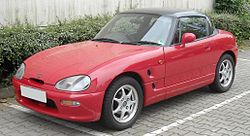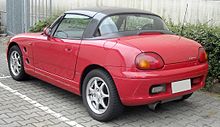Suzuki cappuccino
| Suzuki | |
|---|---|
| cappuccino | |
| Production period: | 1991-1998 |
| Class : | Microcar |
| Body versions : | Roadster |
| Engines: |
Otto engine : 0.66 liters (47 kW) |
| Length: | 3295 mm |
| Width: | 1395 mm |
| Height: | 1185 mm |
| Wheelbase : | 2060 mm |
| Empty weight : | 690-725 kg |
The Suzuki Cappuccino is a by Suzuki in Japan from 1991 to 1998 produced Roadster the kei car class and was at the factory Kosai built in Japan.
In the Japanese small car boom of the early 1990s, the cappuccino was a competitor to the successful mid-engine Honda Beat, which was built around the same time . The Cappuccino is a 3.30 m long and 690 kg heavy convertible with 4-way roof (closed, convertible, targa, T-bar roof) and a 660 cm³ three-cylinder engine with aluminum housing, turbocharger and intercooler . With this engine, the little roadster accelerates from standstill to 100 km / h in under eight seconds.
The retro design won many fans and was especially successful with female customers. The car was sold around 27,000 times from 1992 to 1997. From 1995 the cappuccino was also available with an anti-lock braking system and limited-slip differential . Officially 120 vehicles found their way to the Federal Republic in 1994 . A limited series of 200 vehicles was sold in Japan with a luggage set on the trunk lid and wood trim on the interior.
First introduction
The first official presentation of the cappuccino as a design study was in October 1989 at the 28th Tokyo Motor Show . With the design and the concept of the flexible roof structure, he was a star of this show. The silver metallic colored convertible coupe was presented with a water-cooled 660 cm³ turbo engine, which was called F6A, had 12 valves and an intercooler that sat above the water cooler. The dimensions were slightly different from the model sold later.
The total length of the design study was 3195 mm, the width 1395 mm and the height 1185 mm. The dry weight was 480 kg and the maximum torque of the engine of 125 Nm at 4000 rpm. The tires were 165/65 R 14 74 H.
technology
The water-cooled 657 cm³ engine with a housing made of cast aluminum is positioned lengthways in the front of the engine compartment. With a turbocharger , two overhead camshafts ( DOHC ) and 12 valves, a compression ratio of 8.3: 1 and a multi-point injection system (EPI), the engine developed 47 kW (64 hp) at 6500 rpm. This results in a liter output of 71.5 kW / l.
The power is transmitted from the locked 5-speed gearbox on the engine via a split cardan shaft to a differential on the rear axle and from there via drive shafts to the rear wheels. The weight distribution is 51% in the front and 49% in the rear. The wheels are individually guided on two wishbones and dampened and sprung by spring-damper units . The deceleration is done by four internally ventilated disc brakes .
The instruments consist of a rev counter up to 12,000 rpm (red area 8,500 rpm), a speedometer up to 140 km / h, a cooling water thermometer and the fuel gauge.
successor
The cappuccino has no successor to this day. In 1998 the C2 V8 was presented at the IAA in Frankfurt, but it was never built in series.


